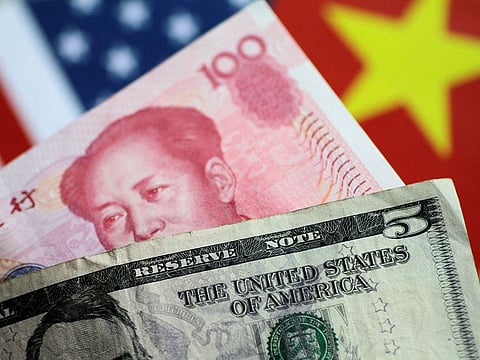China's yuan eases in thin trade as worries over economic impact COVID grows
Market sentiment remains depressed due to growing concern about COVID impact

Shanghai: China's yuan eased against the dollar in thin trade on Wednesday, as market sentiment remained depressed due to growing concern about the impact of the rapid spread of COVID-19 on the economy and trade.
The onshore yuan swung in a very tight range of less than 80 pips in morning deals. Volume contracted to $8.6 billion by around midday, as a vast majority of domestic market participants work from home or call in sick as COVID-19 sweeps through trading floors, currency traders said.
"With so many people getting sick, trading is involuntarily slow," said a trader at a foreign bank, noting trading interest is typically already low towards the year-end holidays.
Virus outbreaks
Those who believe the world economy can avoid the hardest of landings next year are watching China closely to see whether its move to loosen pandemic restrictions, which has triggered virus outbreaks, will help that scenario come about - or end up wrecking it.
Prior to the market's opening, the People's Bank of China (PBOC) set the midpoint rate at 6.965 per dollar, 211 pips, or 0.3 per cent, firmer than the previous fix of 6.9861.
In the spot market, the onshore yuan opened at 6.9705 per dollar and was changing hands at 6.9706 at midday, 96 pips softer than the previous late session close.
"The disruptions from the COVID-19 tsunami to the economic activity in the near term are obvious," said Tommy Xie, head of Greater China research at OCBC Bank.
"The pace of economic recovery will probably hinge on a few factors including when China will pass the current peak of infection and whether the current COVID-19 tsunami in China will breed new variants of concern."
Xie noted that Beijing's earlier-than-expected decision to relax most of its strict virus prevention protocols should be negative for the economy in the near term, but positive for growth in 2023.
Some traders also said the broad weakness in the yuan was capped as markets continued to digest the Bank of Japan's surprise tweak a day earlier to allow bond yield control that permits long-term interest rates to rise more. The adjustment lifted the Japanese yen and pressured the dollar.
By midday, the global dollar index stood at 104.086, while the offshore yuan was trading at 6.9762 per dollar.
Sign up for the Daily Briefing
Get the latest news and updates straight to your inbox



